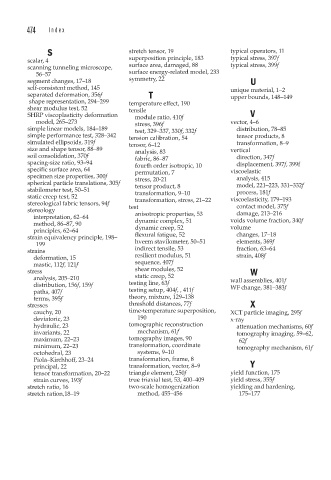Page 482 - Mechanics of Asphalt Microstructure and Micromechanics
P. 482
474 Index
S stretch tensor, 19 typical operators, 11
scalar, 4 superposition principle, 183 typical stress, 397f
scanning tunneling microscope, surface area, damaged, 88 typical stress, 399f
56–57 surface energy-related model, 233
segment changes, 17–18 symmetry, 22 U
self-consistent method, 145 unique material, 1–2
separated deformation, 356f T upper bounds, 148–149
shape representation, 294–299 temperature effect, 190
shear modulus test, 52 tensile
SHRP viscoplasticity deformation module ratio, 410f V
model, 265–273 stress, 396f vector, 4–6
simple linear models, 184–189 test, 329–337, 330f, 332f distribution, 78–85
simple performance test, 328–342 tension calibration, 54 tensor products, 8
simulated ellipsoids, 319f tensor, 6–12 transformation, 8–9
size and shape tensor, 88–89 analysis, 83 vertical
soil consolidation, 370f fabric, 86–87 direction, 347f
spacing-size ratio, 93–94 fourth order isotropic, 10 displacement, 397f, 399f
specific surface area, 64 permutation, 7 viscoelastic
specimen size properties, 300f stress, 20-21 analysis, 415
spherical particle translations, 305f tensor product, 8 model, 221–223, 331–332f
stabilometer test, 50–51 transformation, 9–10 process, 181f
static creep test, 52 transformation, stress, 21–22 viscoelasticity, 179–193
stereological fabric tensors, 94f contact model, 375f
stereology test damage, 213–216
anisotropic properties, 53
interpretation, 62–64 voids volume fraction, 340f
method, 86–87, 90 dynamic complex, 51 volume
principles, 62–64 dynamic creep, 52
strain equivalency principle, 198– flexural fatigue, 52 changes, 17–18
199 hveem stavilometer, 50–51 elements, 369f
strains indirect tensile, 53 fraction, 63–64
deformation, 15 resilient modulus, 51 strain, 408f
mastic, 112f, 121f sequence, 407f
stress shear modules, 52 W
analysis, 205–210 static creep, 52 wall assemblies, 401f
distribution, 156f, 159f testing line, 63f WF change, 381–383f
paths, 407f testing setup, 404f, , 411f
terms, 395f theory, mixture, 129–138
stresses threshold distances, 77f X
cauchy, 20 time-temperature superposition, XCT particle imaging, 295f
deviatoric, 23 190 x-ray
hydraulic, 23 tomographic reconstruction attenuation mechanisms, 60f
invariants, 22 mechanism, 61f tomography imaging, 59–62,
maximum, 22–23 tomography images, 90 62f
minimum, 22–23 transformation, coordinate tomography mechanism, 61f
octohedral, 23 systems, 9–10
Piola–Kirchhoff, 23–24 transformation, frame, 8
principal, 22 transformation, vector, 8–9 Y
tensor transformation, 20–22 triangle element, 250f yield function, 175
strain curves, 193f true triaxial test, 53, 400–409 yield stress, 355f
stretch ratio, 16 two-scale homogenization yielding and hardening,
stretch ration,18–19 method, 455–456 175–177

